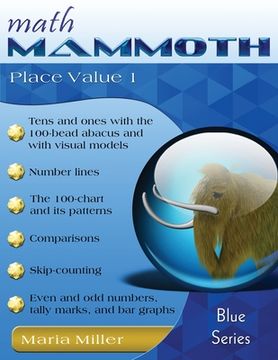Synopsis "Math Mammoth Place Value 1 (in English)"
Math Mammoth Place Value 1 focuses on place value and two-digit numbers and is primarily meant for first grade level math.When children count, they basically just learn numbers as some kind of continuum that goes on without end. With simple counting, your child might not catch on to the inherent structure of the number system. Our number system is based on the idea that if you have lots and lots of objects, the efficient way to count and denote them is with groups of tens, hundreds, and thousands - not individually.The crucial point in understanding the concept of place value is therefore that a certain position represents a certain size group. The digit in each position tells us how many groups of that size there are. For example, in the number 2,381, an adult already knows that the 8 represents eight tens, and not just "8" and that the 3 represents three hundreds, and not just "3". The place of the digit tells us the size of the group, and the digit itself tells how many of that group.The initial lessons of the book that introduce tens and ones use a 100-bead abacus extensively. This 100-bead abacus or school abacus simply contains ten beads on ten rods, for a total of 100 beads. It is not the special abacus used by the Chinese or the Japanese. Each bead simply represents one. The 100-bead abacus lets children both "see" the numbers and use their touch while making them.You will need to purchase this school abacus separately, such as on Amazon, or make your own.The abacus is used in the first lessons, but it is not the only model used in the book. We also use base-ten blocks as a visual representation of two-digit numbers. If you own a set of base-ten blocks (manipulatives), you can use them along with the visual exercises, if desired.Moreover, we also use number lines and the 100-chart. Number lines help to visualize how numbers continue indefinitely and also relate to the concept of measuring. The 100-chart helps the child to be familiar with the numbers below 100 and find patterns in the number system.While most of the lessons in the book focus on place value, students also practice adding and subtracting multiples of ten, and rounding numbers to the nearest ten. The two lessons near the end of the book about tally marks and graphs are real-life applications of two-digit numbers. The last lesson about regrouping can be challenging, thus is optional.

